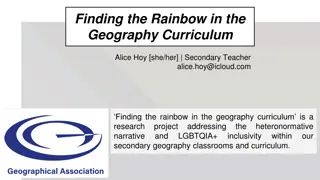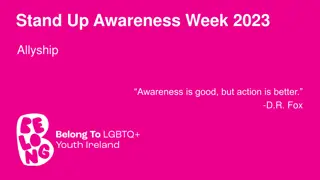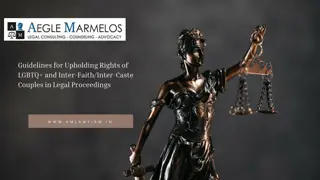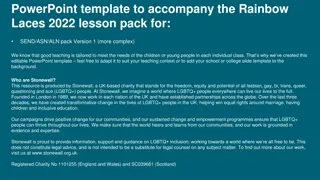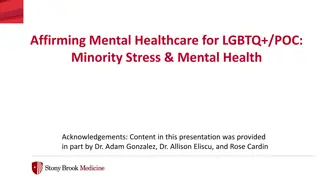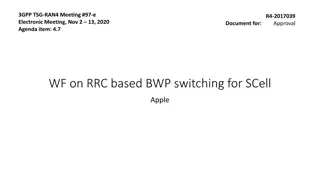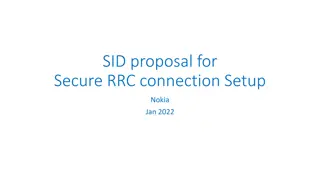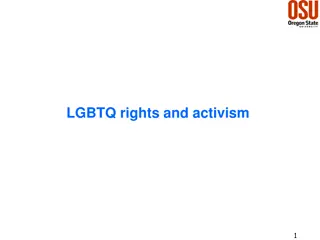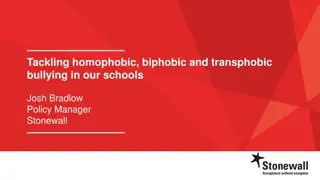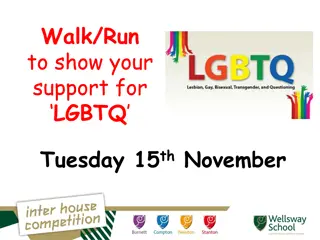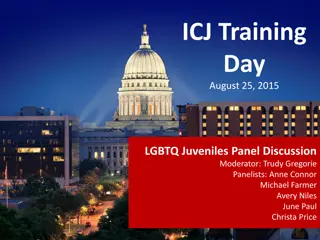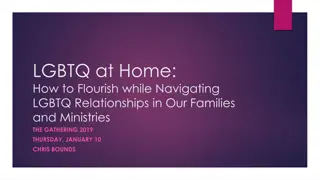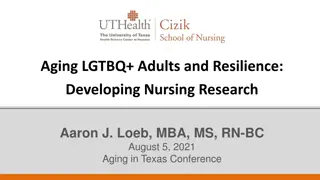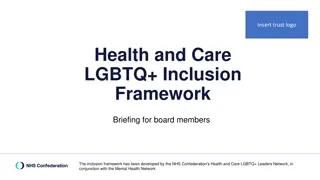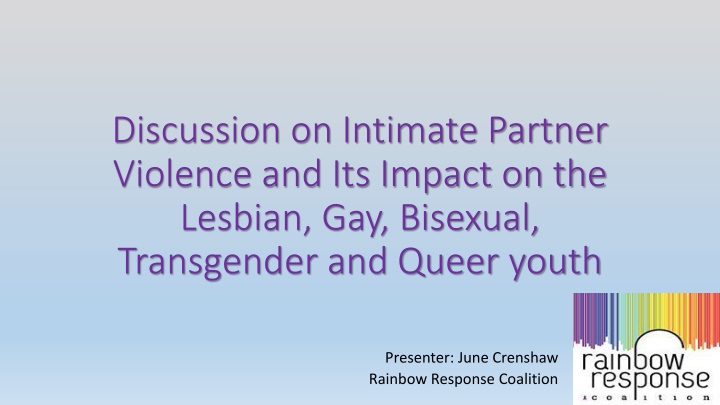
Intimate Partner Violence in LGBTQ Youth Communities
Rainbow Response Coalition is dedicated to raising awareness about intimate partner violence (IPV) within the LGBTQ community. The organization addresses the prevalence of IPV among LGBTQ youth, highlighting issues like homelessness, rejection, bullying, mental health challenges, discrimination, and dating violence. The definition of IPV, standards of abuse, and statistics from reputable sources underscore the urgent need for culturally competent support for LGBTQ survivors.
Download Presentation

Please find below an Image/Link to download the presentation.
The content on the website is provided AS IS for your information and personal use only. It may not be sold, licensed, or shared on other websites without obtaining consent from the author. If you encounter any issues during the download, it is possible that the publisher has removed the file from their server.
You are allowed to download the files provided on this website for personal or commercial use, subject to the condition that they are used lawfully. All files are the property of their respective owners.
The content on the website is provided AS IS for your information and personal use only. It may not be sold, licensed, or shared on other websites without obtaining consent from the author.
E N D
Presentation Transcript
Discussion on Intimate Partner Violence and Its Impact on the Lesbian, Gay, Bisexual, Transgender and Queer youth Presenter: June Crenshaw Rainbow Response Coalition
Rainbow Response Coalition Rainbow Response is a grassroots coalition started in 2007 by a group of DV agencies, organizations and individuals who were concerned about the lack of services, education and support to victims and survivors of intimate partner violence in the Lesbian, Gay, Bisexual, Transgender and Queer (LGBTQ) communities. One of our missions is to raise awareness about the prevalence of partner violence within our communities with the hope of building a collective response to prevent and reduce LGBTQ partner violence. We also work to identify existing organizations that provide culturally competent, supportive and respectful services to LGBTQ survivors. We have been instrumental in the implementation of culturally competent training of MPD since 2009
Some of the many concerns faced by LGBTQ Youth: Homelessness Rejection by family and friends Bullying Mental and behavioral health challenges Discrimination AND Dating Violence and sexual assault
Definition of Intimate Partner Violence Intimate Partner Violence (IPV), also known as domestic violence (DV), is a pattern of behavior where one intimate partner coerces, dominates, or isolates another intimate/sexual partner/BAE/Boo/hookup/crush to maintain power and control over the partner and the relationship.
Same Standards Apply Physical Violence/Abuse Sexual Violence/Abuse Emotional Threats & Intimidation Controlling Finances Isolations or controlling access to friends, family or community Controlling access to medical care/medicine Threats to harm children, animals or destroy property Threats of Outing to family, work, landlord, school, etc. Threats to take children away due to sexual orientation Controlling a partner s gender expression
Many Sources. According to the Centers for Disease Control and Prevention (CDC), the National Coalition of Anti- Violence Programs and the Rainbow Response Coalition: Lesbian, Gay, Bisexual, Transgender and Queer folks experience equal or higher levels of intimate partner violence (IPV) as heterosexuals, with bisexual women suffering much higher rates of IPV in comparison to lesbians, gay men and heterosexual women.
2X 2X Significantly higher rates of dating violence among LGB youth than among non-LGB youth. 42.8 percent of LGB youth surveyed reported being physically abused by their dating partners 29 percent of heterosexual youth reported the same. The rates of sexual victimization for LGB respondents was 23.2 percent nearly double that of heterosexual youth, of whom 12.3 percent reported sexual coercion.
The T Transgender youth reported the highest rates of dating violence, with 88.9 percent reporting physical dating violence.
"Myth of Mutual Battering" This myth is particularly problematic in same-sex/gender abusive relationships as a result of the more pervasive misconception (compared to heterosexual relationships) that two men or two women are "just fighting." This misconception means that same-sex victims are at risk for failing to recognize or understand that they are in an abusive relationship.
Rainbow Response Conducted two surveys (2009 and 2013) Our research found that only 16% of those individuals who reported being abused sought help or reported abuse to authorities. Lesbian and Transgender women victims were more likely to experience violence in shelters due to IPV (4.9 times). Transgender women were 5.2 times more likely to experience police violence when interacting with the police after an IPV incident.
Barriers to Seeking Services and Support IPV is a devastating and deadly problem facing LGBTQ communities. We know that IPV is all too common and way too hidden in our communities, in fact it is nearly invisible. Most domestic violence research, programs and outreach frame the issue as something that only happens in heterosexual relationships. LGBTQ youth report feeling unsafe with law enforcement. Maybe afraid to report because of their own criminal history.
Barriers to Seeking Services and Support LGBTQ youth are not aware of protection, resources and services available to them. Some of the most common reasons LGBTQ people reported not leaving an abusive relationship included didn't know/realize it was abusive and was not aware of resources available to them . Our survey results indicate that 60% of all respondents are not even sure that local laws protect LGBTQ victims. Victims of LGBTQ partner violence may remain silent, fearing that they will be denied protection by law enforcement or by judges who believe in antiquated gender roles and stereotypes.
Barriers to Seeking Services and Support The stigma and shame around partner violence - combined with the stigma and shame around our sexual orientation or gender expression may cause many survivors to remain silent and prevent them from seeking help. Shame, secrecy and social taboo keeps us silent. The Code of Silence - there is so much hate and violence directed at us from society it feels wrong to report other LGBTQ folks. There is a big gap between lived and legal experience, especially in people of color communities. We are sometimes without the support of family, friends and community.
Barriers to Seeking Services and Support Youth don t feel as though they are going to be believed. Youth are forced to tell their traumatic story over and over to several different providers and law enforcement. Youth are afraid of losing the only family and friends they have if they report abuse.
What Can We do? A coordinated response to intimate partner violence and the public safety of the LGBTQ youth. Youth led or youth involved collaboration. Provide training to first responders. Utilize a wide-spread campaign to improve education, outreach and support to LGBTQ youth. Think holistically with assessment, treatment, program planning, forms, etc.
What Can We do? Provide culturally specific services and support to the underserved and marginalized communities. Encourage a trauma informed approach to interacting with LGBTQ folks. Encourage sharing/partnership with medical care providers. Policymakers should ensure that the federal government collects information on sexual orientation and gender identity, whenever demographic data is requested in studies, surveys, and research, including IPV.
What can we do? Supporting victims in only a fraction of the solution. A batterers intervention program is essential to fully addressing IPV.
A Community Response to IPV in the LGBTQQ Communities The Mayor s Office of LGBTQ Affairs in conjunction with the DC Metropolitan Police Department and several LGBTQ community grassroots organizations including RRC, SMYAL, DCTC and The DC Center created a collaborative coalition to address violence that happens to and within the LGBTQ communities. This coalition, Violence Prevention and Response Team (VPART), oversees the training of officers; tracks and dissimilate hate and domestic violence calls/incidence; creates a community rapid response; identifies and addresses trends; and performs outreach to affected community.
Rainbow Response Coalition If you or someone you know has been affected by domestic violence, you can seek help by calling a helpline or seeking counseling and information from one of the LGBTQQ- friendly resources listed below. The Anti-Violence Project: serves people who are LGBTQQ; Hotline 1-212-714-1141, Bilingual 24/7 The Network La Red: serves people who are LGBTQQ, poly and kink/BDSM; Bilingual. Hotline - Voice: 1-617-742-4911; Toll-Free: 1-800-832-1901; TTY: 1-617-227-4911 FORGE: serves transgender and gender nonconforming survivors of domestic and sexual violence; provides referrals to local counselors, 1-414-559-2123 Let's Talk About It: A Transgender Survivor's Guide to Accessing Therapy National Sexual Assault Hotline: 1-800-656-HOPE (4673) 24/7 or Online Counseling Love is Respect Hotline (for youth): online chat; 1-866-331-9474 (24/7); TTY: 1-866-331-8453; or Text loveis to 22522 LGBTQ National Help Center: Youth Hotline 1-800-246-PRIDE (7743); LGBTQ National Hotline 1-888-843-4564; Sage LGBTQ Elder Hotline 1-888-234-7243; or Online Chat at http://www.volunteerlogin.org/chat/ Gay Men s Domestic Violence Project Hotline: 1-800-832-1901 Northwest Network serves LGBTQ survivors of abuse; can provide local referrals: 1-206-568-7777 Please visit our website www.rainbowresponse.org Facebook www.facebook.com/rainbow.response.coalition



